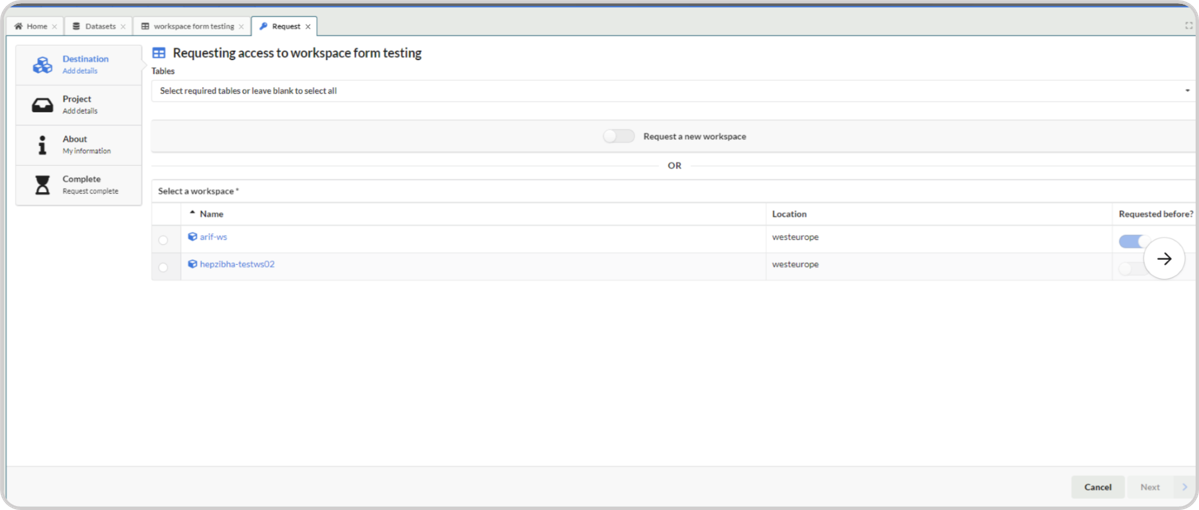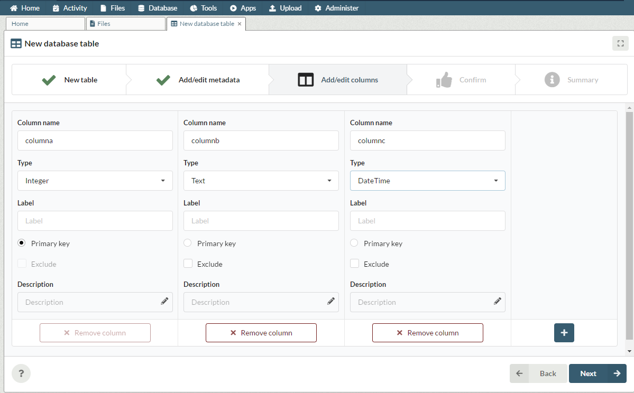Blogs & News
DRE Feature Highlights Q3 2024
In October, Aridhia hosted its Feature Highlights call for DRE customers, drawing attention to recently released features in Workspaces and FAIR Data Services, as well as giving an update on the projected roadmap of the year ahead. Let’s take a look at some of the highlights.
FAIR Data Services
External Dataset Management
For a long time now, customers have been able to provide a metadata listing in FAIR while hosting the data itself in their own external databases. However, this setup involved the help of Aridhia’s Service Desk to set up the connection, test, etc.
The management of this process is now self-service within the FAIR user interface. Users can provide details of the external data, check the connection to it, and that’s it. This will remove barriers and save time for users by allowing them to easily connect to existing data sources, rather than going through the process of ingesting the data into FAIR.
In addition to the supported database types (Postgres, Azure Synapse, Azure SQL Server), users can also self-service a connection to a deployed Federated Node. You can read more about the Federated Node here.
User Groups
The introduction of this feature allows for the creation of groups of users who can then be assigned dataset permissions as a set. For example, a data owner could add a user group to their dataset as reviewers, owners, etc.
A user’s profile will now show which User Groups they are a member of. Importantly, the permissions assigned to a User Group do not supersede a user’s individual permissions, so this cannot be used as a backdoor to acquiring levels of access beyond a user’s expected scope.
As further updates are made to FAIR, User Groups will be a selectable option for many other administrative sharing functions, such as sharing cohorts or dataset collections.
Workspaces
Workspace Requests in DARs
A significant new feature that brings what used to be a more ad-hoc process into the hands of DRE administrators. Users used to request workspaces and go through the approval workflow before beginning to request access to data. Now users can request a new workspace as part of their Data Access Request (DAR).
As part of a DAR, as well as selecting from pre-existing workspaces, a new workspace can be requested. Upon submission, the data owner of the dataset in FAIR will receive the DAR for review, and Tenant Administrators in Workspaces will receive the same details alongside a workspace creation request. There is no requirement for one approval to be completed before another. This will save time and effort on both the user and administrator side.
Data Table Creation Wizard
This feature was touched upon in the previous Feature Highlight. Workspaces has long supported the ability to convert .csv files into database tables, through a conversion wizard. However, ways of streamlining this process came to light over time, so as part of the recent UX refresh, this was chosen as a target for improvement.
Creating a data table now uses a wizard-style process that brings FAIR and Workspaces closer to a unified design. You can create new tables from scratch, or by using a .csv file in the workspace as a template. Likewise, the process walks you through the addition of metadata, and includes a new type-guessing algorithm, in an effort to automate more of the process in a more accurate manner than before. The wizard also allows for the exclusion of columns from the final data table, a newly designed preview and summary page, and more.
Audit Extract
In many situations it is important for administrators of organisations to access and retain audit data from workspaces for a variety of security and governance purposes. Previously, administrative users had to access individual workspaces and access audit data from there. This new feature allows Tenant Administrators to retrieve audit data from a single location, from not just active workspaces, but deleted ones as well. Once processed, administrators can download a zip file of all the associated audit data.
New Upload User Interface
A new wizard takes users through the file upload process for workspaces. This new streamlined process allows for a simpler experience and more control for users over the overall layout of their file system. It also features customisable messaging and new file indicators. The main takeaway is that the useability of the workspace file system is seeing incremental improvements and will continue to do so in the coming months.
Collabora
We mentioned in a previous Feature Highlight that Workspaces would see the introduction of Collabora, allowing for the opening of files in formats typically serviced by Word, Excel, PowerPoint, Publisher, etc. You can find a current list of supported types here. Taking a tour of some examples, we showed the high level of performance and already supported features in this early release. We look forward to showing off more features as they are made available.
The Federated Node
 An update was given on the status of the Federated Node (FN), our open-source federated component we have been developing alongside the PHEMS consortium. Subject to the most recent pen testing report, the FN is due to be released in the next few weeks. It will be released under the GNU General Public License, releasing under this license means that the Federated Node will be free to use, and that other projects can modify and distribute the source code as they need, while ensuring that any subsequent projects based on the FN must also be open-source. You can read more about the development of the Federated Node here, and we will be releasing another blog very soon, explaining how to set up and make best use of the FN.
An update was given on the status of the Federated Node (FN), our open-source federated component we have been developing alongside the PHEMS consortium. Subject to the most recent pen testing report, the FN is due to be released in the next few weeks. It will be released under the GNU General Public License, releasing under this license means that the Federated Node will be free to use, and that other projects can modify and distribute the source code as they need, while ensuring that any subsequent projects based on the FN must also be open-source. You can read more about the development of the Federated Node here, and we will be releasing another blog very soon, explaining how to set up and make best use of the FN.
Keep an eye out for further Feature Highlights to come as we head into 2025.
November 7, 2024
Andrew Fox-McKay
Andrew joined Aridhia in January 2018 to support the Enablement Team. He studied Ecology and Animal Behaviour at the University of St Andrews before working in various sales and marketing positions for technology companies. Outside of sales/marketing, Andrew also provides client support for the likes of Great Ormond Street Children's Hospital and the European Prevention of Alzheimer's Dementia Consortium (EPAD).


